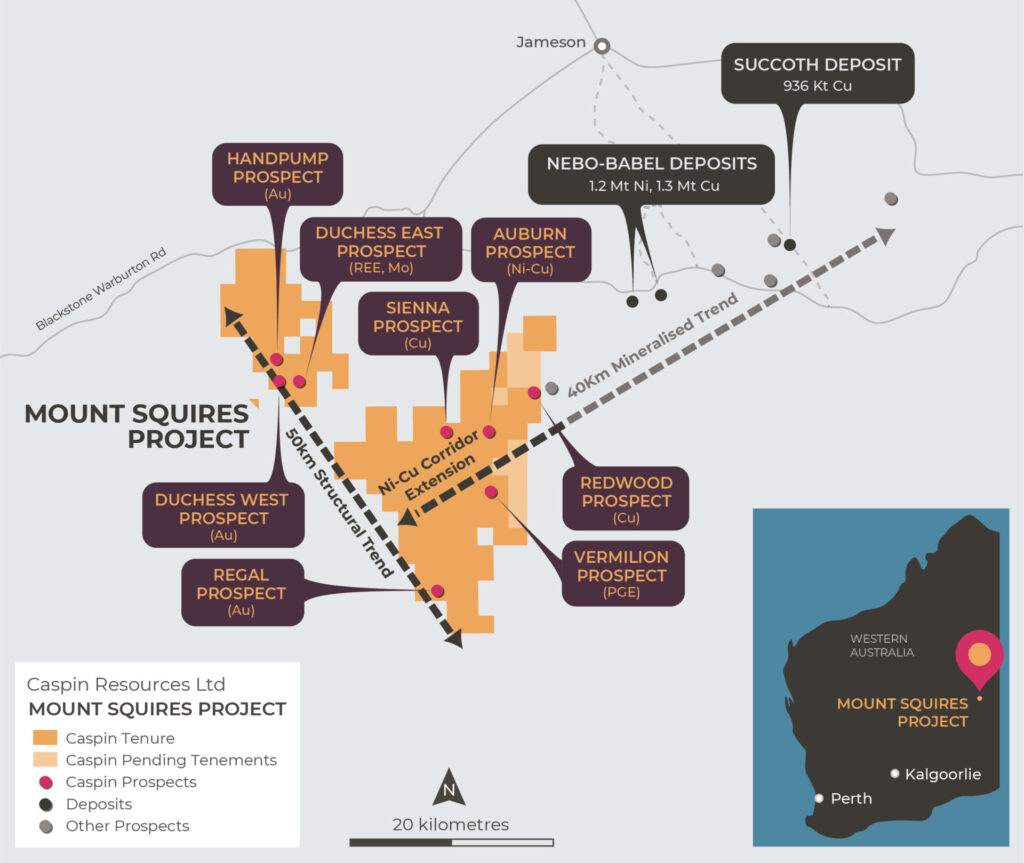
Mount Squires
Mount Squires
Ni-Cu
Au
REE
Mount Squires is a large scale, greenfield-style gold and base metal project that lies within the West Musgrave region of Western Australia and is 100% owned by Caspin. The Mount Squires Project is located adjacent to the western border of BHP’s West Musgrave Project which hosts the large Nebo-Babel Ni-Cu sulphide deposits, approximately 1,700km northeast of Perth, Western Australia.
Project Highlights
- 750km2 land holding including a 40+km structural corridor with significant gold mineralisation and a 17km strike extension of the West Musgrave nickel and copper corridor.
- Significant gold and copper mineralisation already identified close to surface with limited drilling.
- Extremely under-explored due to previous remoteness and access issues.
- Highly strategic land position along strike from the $1.7b Nebo-Babel nickel-copper development.

The Mount Squires Project is within the Musgrave Province in the Central Desert region of Western Australia. The Musgrave Province is a Mesoproterozoic belt covering an area up to 800km long and 350km wide that straddles the borders between the Northern Territory, Western Australia and South Australia. It lies at the convergence of Australia’s main Proterozoic structural trends that reflect the amalgamation of the North, West, and South Australian cratons. It is bounded by Neoproterozoic to Paleozoic basins. The West Musgrave refers to that portion of the province that lies predominantly within the state of Western Australia.
The West Musgrave region of Western Australia hosts one of the most important clusters of mafic–ultramafic layered intrusions globally. This layered intrusion is known as the “Giles Complex” and is considered to be one of the world’s largest layered intrusions. Giles-age mafic intrusions host the Nebo-Babel Ni-Cu sulphide deposits, discovered in 2000 and currently under development by BHP.
Much of the present Musgrave Province consists of isolated prominent ridges and topographic highs (comprising outcrops of competent weathering resistant lithologies) separated by large areas of peneplain and aeolian sand dune covered sequences with little to no outcrop. Most of the Mount Squires Project area is covered by calcrete, aeolian sand dunes and partly consolidated colluvium, with outcropping crystalline basement rocks accounting for only 5% of the project area.
Nickel-Copper Exploration
The Mount Squires Project contains a 17km corridor of mafic rocks, including Giles-complex intrusives, extending from the West Musgrave Project on the eastern tenement boundary. The Company has used Ultra-fine fraction (UFF) soil geochemistry and airborne electromagnetic (AEM) techniques to provide first-pass exploration coverage of the corridor. UFF soil geochemistry has been highly effective at defining new anomalies beneath shallow sand cover. The effectiveness has been confirmed by the discovery of copper mineralisation in minor rock outcrops at the Sienna Prospect.
It is worth noting that the neighbouring Nebo and Succoth (~1Mt contained Cu) deposits have no surface expression at all, lying beneath shallow sand cover and the Babel Deposit has only a very small subcrop of approximately 5 square metres, which also displays malachite. Therefore, any surface expression of mineralisation in this region is highly encouraging.

A Significant Rare Earth Discovery
The Company has made a discovery of rare earth element (REE) mineralisation at the Duchess Prospect following the drilling of a broad multi-element soil geochemical anomaly. Several phases of drilling have returned significant intersections such as 27m @ 0.70% TREO including a higher-grade zone of 12m @ 1.15% TREO comprising 1,662ppm neodymium (Nd2O3), 404ppm praseodymium (Pr6O11), 325ppm dysprosium (Dy2O3) and 54ppm terbium (Tb4O7) in MSRC0003 and 12m @ 0.81% TREO including a higher-grade zone of 6m @ 1.15% TREO comprising 1,946ppm Nd2O3, 455ppm Pr6O11, 296ppm Dy2O3 and 51ppm Tb4O7 in MSRC0006.
Mineralisation is a volcanic-hosted, hydrothermal-style, deposited along faults and lithological contacts, a unique style in Australia. These faults and contacts have provided pathways for hydrothermal fluids to mobilise REEs which have then been deposited at points of rheological contrast such as the volcaniclastic-rhyolite contact. This primary mineralisation has the potential to be enriched through secondary weathering processes, with many of the significant intercepts occur in weakly weathered rock or saprock.
The large proportion of heavy rare earth elements (HREE), such as Dy and Tb, is highly significant given the much greater value of these metals compared to light rare earth elements (LREE) such as Nd and Pr. The Company has observed that the proportion of HREE to LREE can vary significantly, ranging from 23% up to 73%.

Gold Exploration
Gold mineralisation was first discovered in 2008 at the Handpump Prospect, during reconnaissance drilling of a soil lag anomaly. Several phases of drilling have returned very significant results, such as 43m @ 1.18g/t Au including 9m @ 3.25g/t Au. Mineralisation has been observed in quartz-breccia at surface.
The Handpump Prospect is on a 40km north-south structural trend striking down the western side of the project. The trend has additional soil geochemical anomalies, such as the Regal Prospect, at the southern margin of the project. The Regal Prospect is a priority for further exploration.

Next Steps
The Company has already found sufficient encouragement from results to date to warrant an escalation of exploration activities during the 2023 field season. Conducting further soil sampling, geophysics and reconnaissance drilling along both mineralisation trends.
For further information on the Mount Squires Project please view our latest Announcements: